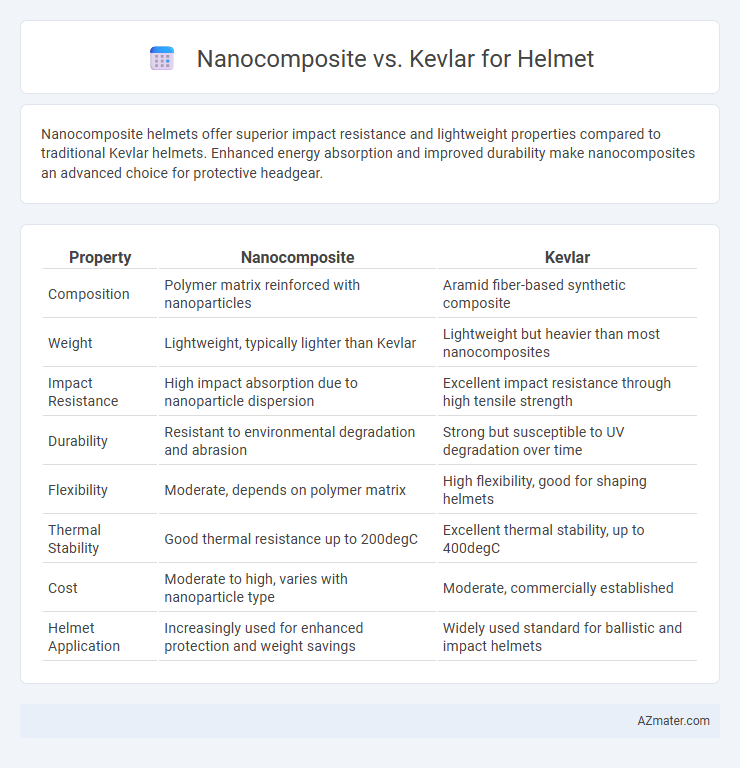Nanocomposite helmets offer superior impact resistance and lightweight properties compared to traditional Kevlar helmets. Enhanced energy absorption and improved durability make nanocomposites an advanced choice for protective headgear.
Table of Comparison
| Property | Nanocomposite | Kevlar |
|---|---|---|
| Composition | Polymer matrix reinforced with nanoparticles | Aramid fiber-based synthetic composite |
| Weight | Lightweight, typically lighter than Kevlar | Lightweight but heavier than most nanocomposites |
| Impact Resistance | High impact absorption due to nanoparticle dispersion | Excellent impact resistance through high tensile strength |
| Durability | Resistant to environmental degradation and abrasion | Strong but susceptible to UV degradation over time |
| Flexibility | Moderate, depends on polymer matrix | High flexibility, good for shaping helmets |
| Thermal Stability | Good thermal resistance up to 200degC | Excellent thermal stability, up to 400degC |
| Cost | Moderate to high, varies with nanoparticle type | Moderate, commercially established |
| Helmet Application | Increasingly used for enhanced protection and weight savings | Widely used standard for ballistic and impact helmets |
Introduction: The Quest for Superior Helmet Materials
Nanocomposites offer enhanced impact resistance and lightweight properties by integrating nanoscale fillers like carbon nanotubes or silica into polymer matrices, making them ideal for advanced helmet designs. Kevlar, a well-established aramid fiber, provides exceptional tensile strength and ballistic protection while maintaining flexibility, widely trusted in military and sports helmets. Comparing these materials involves assessing factors such as durability, weight, energy absorption, and manufacturing cost to identify the optimal choice for superior helmet performance.
Understanding Nanocomposites: Structure and Properties
Nanocomposites for helmets consist of a polymer matrix embedded with nanoparticles, such as carbon nanotubes or silica, which significantly enhance mechanical strength, impact resistance, and thermal stability compared to traditional materials. Kevlar, a well-known aramid fiber, offers high tensile strength and excellent energy absorption but lacks the enhanced lightweight and multifunctional properties provided by nanocomposites. The nanoscale reinforcement in these composites creates a superior interface between the matrix and fillers, resulting in helmets that combine durability, reduced weight, and improved overall performance.
The Legacy of Kevlar in Helmet Manufacturing
Kevlar has established a formidable legacy in helmet manufacturing due to its exceptional tensile strength and impact resistance, making it a preferred material for ballistic and motorcycle helmets. Nanocomposites, incorporating nanoparticles such as carbon nanotubes or silica, are emerging as advanced alternatives by enhancing mechanical properties, reducing weight, and increasing durability beyond traditional Kevlar. Despite the rise of nanocomposites, Kevlar's proven performance in absorbing and dissipating impact energy continues to set industry standards for safety and reliability in protective headgear.
Impact Resistance: Nanocomposite vs Kevlar
Nanocomposite materials offer superior impact resistance in helmets by efficiently dissipating energy across their nanoscale reinforcements, reducing the risk of fractures. Kevlar, known for its high tensile strength and flexibility, provides excellent resistance against penetration and blunt force but may not distribute impact energy as uniformly as nanocomposites. Advances in nanocomposite technology enable helmets to achieve enhanced durability and lighter weight compared to traditional Kevlar-based designs.
Weight and Comfort: Evaluating User Experience
Nanocomposite helmets offer significantly reduced weight compared to Kevlar, enhancing comfort during extended use by minimizing neck strain and fatigue. The advanced material composition of nanocomposites allows for superior impact absorption with thinner, lighter layers, contributing to enhanced breathability and better ventilation. Kevlar helmets provide excellent ballistic protection but tend to be heavier, which can compromise user comfort over prolonged wear.
Durability and Environmental Resistance
Nanocomposite helmets outperform Kevlar in durability due to their superior impact resistance and enhanced fracture toughness, which prolongs service life under extreme stress conditions. Their environmental resistance is markedly higher, offering excellent protection against UV radiation, moisture, and temperature fluctuations that typically degrade Kevlar fibers. This combination of durability and environmental resilience makes nanocomposite materials a preferred choice for high-performance, long-lasting helmet applications.
Cost Analysis and Commercial Viability
Nanocomposite helmets offer significant cost advantages over Kevlar by utilizing advanced polymer matrices combined with nanoscale fillers, resulting in enhanced impact resistance at a lower material expense. The production scalability of nanocomposites supports mass manufacturing with reduced energy consumption and shorter curing cycles compared to Kevlar, improving overall commercial viability. Despite Kevlar's established reputation for durability, nanocomposites present a competitive balance between performance and affordability, attracting manufacturers seeking innovation with cost efficiency.
Safety Standards and Certification Compliance
Nanocomposite helmets exhibit superior impact resistance and enhanced energy absorption compared to traditional Kevlar helmets, meeting or exceeding rigorous safety standards such as DOT, ECE, and Snell certifications. The integration of nanomaterials improves structural integrity and reduces weight, which enhances wearer protection and comfort during high-velocity impacts. Compliance with international safety certifications ensures that nanocomposite helmets provide reliable performance under stringent testing protocols, making them a preferred choice for modern protective headgear.
Future Trends in Helmet Material Innovation
Nanocomposite materials in helmet manufacturing exhibit superior impact resistance and lightweight properties compared to traditional Kevlar, making them a pivotal focus in future safety gear innovation. Advances in nanotechnology enable the integration of graphene and carbon nanotubes within polymer matrices, enhancing energy absorption and durability beyond Kevlar's capabilities. The transition towards nanocomposites promises helmets that offer improved protection, reduced weight, and increased wearer comfort, heralding a new era in personal protective equipment.
Conclusion: Choosing the Optimal Helmet Material
Nanocomposite helmets offer superior impact resistance and lighter weight compared to Kevlar, enhancing both safety and comfort for users. Kevlar provides excellent tensile strength and durability, making it ideal for high-stress environments but often at the cost of added weight. Selecting the optimal helmet material depends on the specific application requirements, where nanocomposites excel in versatility and lightweight protection while Kevlar remains preferred for extreme durability.

Infographic: Nanocomposite vs Kevlar for Helmet
 azmater.com
azmater.com